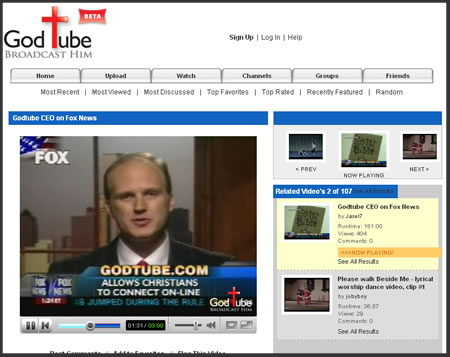It will be interesting to see if the now-formidable legal department of Google drops a letter to a new site, GodTube that apes their YouTube video service.
 GodTube, you won’t be surprised to hear, shows videos that praise god. It’s yet to launched, with the expected out-of-beta date being 1 May.
GodTube, you won’t be surprised to hear, shows videos that praise god. It’s yet to launched, with the expected out-of-beta date being 1 May.
Looking at the site, loving god doesn’t necessarily mean that you observe the rights of those who have gone before you. The less-than-coincidental name similarity isn’t the only thing that will remind you of YouTube. GodTube also closely-mimics the general look and feel of YouTube.
Similarities don’t end there, they even stretch to the GodTube strapline Broadcast Him, only a small adjustment from YouTube’s Broadcast Yourself.
Listening to GodTube’s CEO, Chris Wyatt, speaking on Fox News, he claims to have “come up with the idea for GodTube” when he was attending a seminary in Dallas. Quite what the idea he came up with he didn’t elucidate, but if it was “I know let’s copy YouTube, but call it GodTube,” we’d hardly call it an idea.

Wyatt is keen to tell everyone about how well it’s doing, claiming that within 60 days it was the most-trafficked Christian stream video site on the Internet. His ambitions don’t appear to stop there, as if they continue at this rate, Wyatt claims they “will become the most trafficked Christian Web site on the Internet.”
By trafficked, we assume he means the amount of bits that they shift. As they’re putting out video (the most bit-laden content format available), his claims start to sound significantly less impressive.
One area GodTube differs significantly from YouTube is in how open they are in showing the videos of those who want to upload content to their site. YouTube doesn’t put a human filter in the way, understanding that given the number of videos that are uploaded, it just isn’t realistic.
GodTube may struggle with their approach, suffering a plague of videos rather than the mythical plague of locusts. They’re going to pass all submitted content through two manual filters – real people. The first will check if it’s presentable to the public, the second to ascertain its Theological implications!
Here’s a little sample. It’s only a minute long, but will give you an indication of what to expect. Get read for an explanation of a banana. We kid you not.

 Sitting on the tube, opposite such an ad, I figured that there were only two possible companies which could be accused of controlling 80% of information on the Web; it could plausibly refer to either Internet Explorer’s market share (and would therefore be an advert for Firefox) or Google’s market share. Since I knew Mozilla wasn’t planning any advert like this, I assumed that it was a competitor to Google, and concluded it was probably Ask (since neither Yahoo or Microsoft would manage to think outside the box to such an extent). However, I dismissed that idea instantly as it seemed so unlikely that a well respected company would attempt such a pathetic campaign, and that therefore it must be some new search engine with far too much venture capital. By that point I had lost interest, and began examining the ventilation panel.
Sitting on the tube, opposite such an ad, I figured that there were only two possible companies which could be accused of controlling 80% of information on the Web; it could plausibly refer to either Internet Explorer’s market share (and would therefore be an advert for Firefox) or Google’s market share. Since I knew Mozilla wasn’t planning any advert like this, I assumed that it was a competitor to Google, and concluded it was probably Ask (since neither Yahoo or Microsoft would manage to think outside the box to such an extent). However, I dismissed that idea instantly as it seemed so unlikely that a well respected company would attempt such a pathetic campaign, and that therefore it must be some new search engine with far too much venture capital. By that point I had lost interest, and began examining the ventilation panel.
 GodTube, you won’t be surprised to hear, shows videos that praise god. It’s yet to launched, with the expected out-of-beta date being 1 May.
GodTube, you won’t be surprised to hear, shows videos that praise god. It’s yet to launched, with the expected out-of-beta date being 1 May.
 Miglia have not only signed a deal with software suppliers Equinux, but have a package available already with the software, called The Tube. They’re calling the hardware and software bundle the TVMini Express.
Miglia have not only signed a deal with software suppliers Equinux, but have a package available already with the software, called The Tube. They’re calling the hardware and software bundle the TVMini Express. Equinux are confident with the swift reaction of the software, as they tell us it was written “from the ground up” in Cocoa, Apple’s object-oriented application environment designed specifically for developing Mac OS X-only native applications. ie it wasn’t written for Windows and ported over to the Mac.
Equinux are confident with the swift reaction of the software, as they tell us it was written “from the ground up” in Cocoa, Apple’s object-oriented application environment designed specifically for developing Mac OS X-only native applications. ie it wasn’t written for Windows and ported over to the Mac. We mourned the lack of Mac and Linux support. Given that all Polycom needed to do was write a driver or two to get it running, we were disappointed that there was no movement on this
We mourned the lack of Mac and Linux support. Given that all Polycom needed to do was write a driver or two to get it running, we were disappointed that there was no movement on this  Ofcom has just announced that it will be carrying out an inquiry into the whole area.
Ofcom has just announced that it will be carrying out an inquiry into the whole area. The inquiry will be led by Richard Ayre, a former Deputy Chief Executive of BBC News. He is expected to receive extensive input from the premium rate services regulator, ICSTIS, who are already investigating a number of individual cases.
The inquiry will be led by Richard Ayre, a former Deputy Chief Executive of BBC News. He is expected to receive extensive input from the premium rate services regulator, ICSTIS, who are already investigating a number of individual cases. Polycom have announced that they’re going to support more VoIP software than just Skype on the current
Polycom have announced that they’re going to support more VoIP software than just Skype on the current  After weeks of speculation and one
After weeks of speculation and one 
 The unit has a 40Gb hard drive that Apple says can “store up to 50 hours of video, 9,000 songs, 25,000 photos or a combination of each and is capable of delivering high-definition 720p output.”
The unit has a 40Gb hard drive that Apple says can “store up to 50 hours of video, 9,000 songs, 25,000 photos or a combination of each and is capable of delivering high-definition 720p output.” For folks a little bored of staring at the vast expanses of white space around their Google homepage comes the news that the page is finally skinnable.
For folks a little bored of staring at the vast expanses of white space around their Google homepage comes the news that the page is finally skinnable. All of themes are dynamic and change their appearance according to your own local time of day, current weather conditions or season.
All of themes are dynamic and change their appearance according to your own local time of day, current weather conditions or season. Personally, we couldn’t think of anything worse than being stuck in a windowless office and relying on Google to tell you when the sun has gone down, but we get her point.
Personally, we couldn’t think of anything worse than being stuck in a windowless office and relying on Google to tell you when the sun has gone down, but we get her point.